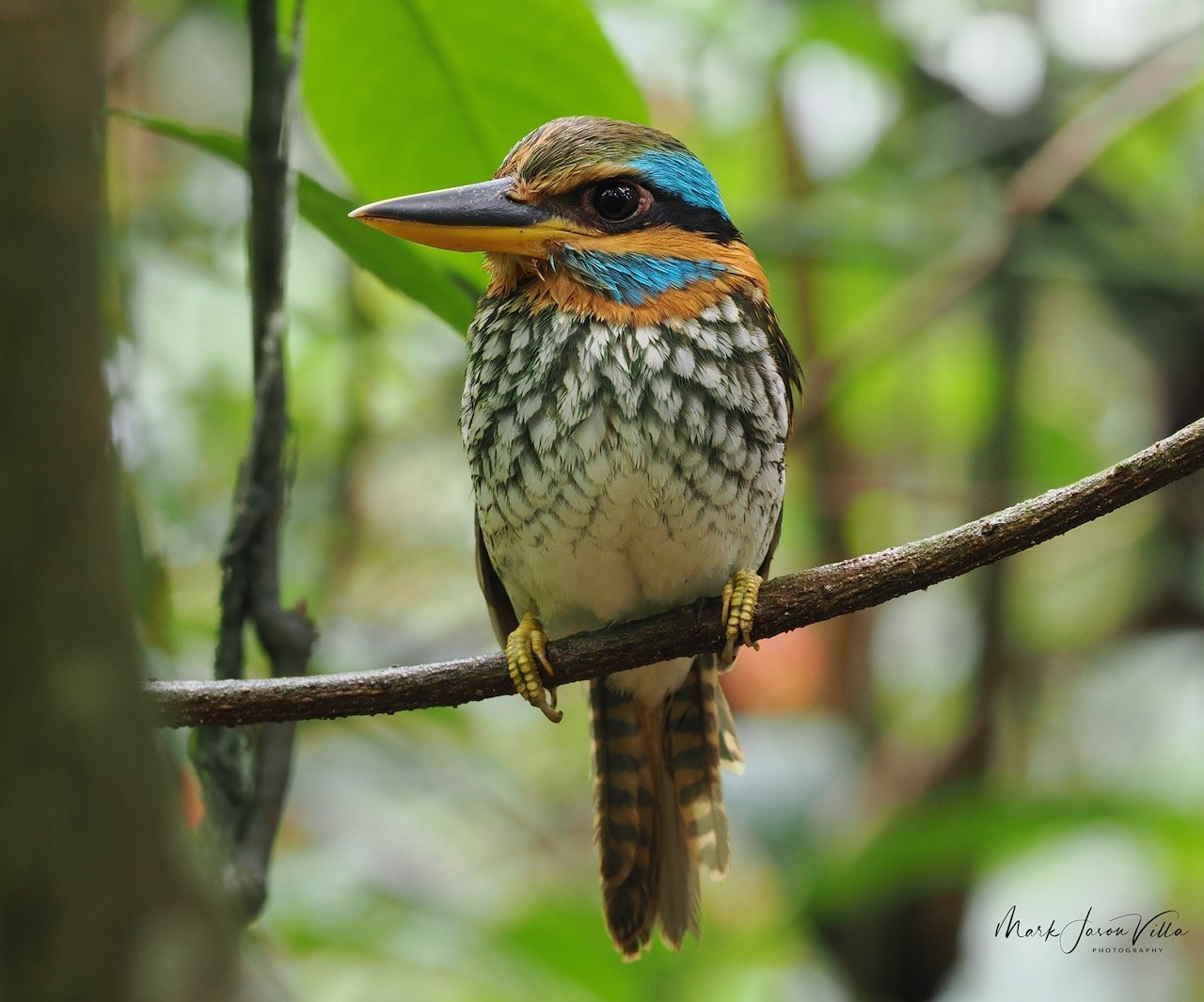PHILIPPINES - OFF THE BEATEN TRACK TOUR
Day 1 ARRIVAL IN MANILA, LUZON - 9th March
This is purely an arrival day into Manila and no birding activities are planned.
Day 2 LA MESA ECO PARK, LUZON
Our first stop is the La Mesa Ecopark and our main target for this site is the vulnerable Ashy Thrush, which can be difficult in other sites but has been fairly reliable in this park close to Manila. Other species we will be on the look out for include the Spotted Wood Kingfisher, White-eared Brown-Dove, Philippine Pygmy Woodpecker, Lowland White-eye and Grey-backed Tailorbird. Occasional highlights include Red-bellied Pitta, Hooded Pitta, or Mangrove Blue Flycatcher. We will then drive to Infanta where we will spend 2 nights.
Days 3 - 4 INFANTA ROAD
Infanta Road, in Quezon province, is a popular easy roadside birding hotspot. We hope to find some fruiting trees which attract a lot of frugivorous birds including Philippine Fairy‑bluebird, Amethyst Brown‑Dove, Yellow-breasted Fruit-Doves and White-eared Brown-Doves. We also hope to connect with some rarer doves such as Flame‑breasted Fruit‑Dove and Cream‑bellied Fruit‑Dove. The hagimit fig trees are also very popular among the smaller but equally appealing flowerpeckers including Orange‑bellied and Olive‑backed Flowerpeckers, often mixed with Buzzing and Bicolored Flowerpeckers. Insectivores like Blue‑headed Fantail, Sulphur-billed Nuthatch, Elegant Tit, Yellowish White‑eye, Citrine Canary‑Flycatcher and Lemon‑throated Leaf Warbler are often encountered in mixed species flocks here. Other highlights include Black-crowned Babbler, Bicol Ground Warbler, Rufous Hornbill, and the enigmatic Whiskered Pitta is possible in season.
Day 5 MOUNT BANAHAW
Should we miss the Whiskered pitta in Infanta, we have another chance at a site near Mt. Banahaw in Bangkong Kahoy Valley. It is about an hour's hike but the effort will hopefully be rewarded by good views of the Whiskered Pitta. Along the trail, we hope to bump into mixed-species flocks including Chestnut‑faced Babbler, Sulphur‑billed Nuthatch, Green‑backed Whistler, Yellowish White‑eye, Blue‑headed Fantail, and Elegant Tit. Mountain Leaf‑Warbler, Mountain White‑eye, and Balicassiao may also join these groups.
Day 6 FLY TO PANNZIAN, LUZON
Today we will fly from Manila to Laoag City, in Northwest Luzon. If we have time, we will visit some nearby grasslands around Laoag which are known for attracting rare winter migrants such as the vulnerable Japanese Yellow Bunting. Sightings of Philippine Collared Dove are possible in open areas. The nearby wetlands and lakes also hold good numbers of Philippine Duck. We will then travel north along coastal road towards Pagudpud. We have 2 nights stay here.
Days 7 - 8 KALBARIO PATAPAT NP - BAGGAO, LUZON
We will spend the day at Kalbario‑Patapat Natural Park where our main target will be the vulnerable Cordillera Ground‑warbler, one of the skulky Luzon endemic restricted to northern Luzon. Also possible here is the the rare Blue‑breasted Blue Flycatcher, a near‑threatened understory species often joining mixed‑species flocks. Other birds possible include Philippine Trogon, Philippine Fairy Blue-bird, Northern Sooty Woodpecker and the impressive Northern Rufous Hornbill is more regularly observed gliding across valleys and calling loudly from treetops. There is also a chance for Sierra Madre Crow, quite a distinctive split from Slender-billed Crow.
There's a fine selection of other sought-after species such as White-lored Oriole, Golden-crowned Babbler and Furtive Flycatcher. A fair amount of luck would be required to see other extremely rare species such as Spotted Imperial-Pigeon, Cream-bellied Fruit Dove, Luzon Bleeding-Heart or Indigo-backed Kingfisher. Other Philippine species to be found here include Purple Needletail, Philippine Cuckoo-Dove, Scale-feathered & Rough-crested Malkoha, Rufous Coucal, Luzon Hornbill, Sooty Woodpecker, White-browed Shama, Rufous Paradise-Flycatcher, Trilling Tailorbird and Thick-billed Flowerpecker.
On Day 8 we will drive along the north coast on the way to northeast Luzon. On the way we will be stopping by some good and not often explored forest. We will be on the lookout for birds we may have missed or other new addition to our list. Slim chance but Philippine Eagle has been reported in this area!
Day 9 BLUE WATERS
Blue Waters in Baggao, Cagayan in northeastern Luzon is best known as one of the few accessible locations where the critically endangered Isabela Oriole can be reliably seen. We will spend the day here looking for the oriole but there are also plenty of other birds to look including White-lored Oriole, Luzon Striped-Babbler, and Luzon Black-and-White Triller and Sierra Madre Ground Warbler.
Day 10 FLY TO MANILA - BOHOL
This morning we will fly to Bohol and make our way up to the Chocolate Hills for a three nights stay.
Days 11 - 12 BOHOL
We are going to explore the forests of Bohol in the Central Visayas and in particular the densely forested Rajah Sikatuna National Park for species such as Chocolate Boobook, Everett's Scops Owl, Samar Hornbill, Northern Silvery Kingfisher, Short-tailed Drongo, Visayan Babbler, Yellow-breasted Tailorbird, Bohol’ Sunbird (or rather the local form of Metallic-winged Sunbird) and hopefully the stunning Visayan (Wattled) Broadbill.
Other species present include Buff-spotted Flameback, Philippine Frogmouth, Black-faced Coucal, Philippine Trogon, Philippine Oriole, Azure-breasted (Steere’s) Pitta, Philippine Pitta, Pygmy Swiftlet, Striated Wren-Babbler (Streaked Ground Babbler), Philippine Bulbul, Rufous-tailed Jungle Flycatcher, Visayan Blue Fantail, Yellow-bellied Whistler, Brown Tit-Babbler, Philippine Leaf Warbler, Philippine Leafbird and both Buzzing & Red-keeled Flowerpeckers. Nights on Bohol.
Day 13 - 16 MANILA - NEGROS
Fly to Manila to Bacolod on Negros where we will be targeting a number of highly sought-after endemics and localised species including Philippine Honey Buzzard, Philippine Serpent-Eagle, Luzon Boobook, Negros Scops Owl, Philippine Nightjar, Pink-bellied Imperial-Pigeon, White-eared & Amethyst Brown Dove (split by some authorities as Grey-breasted Brown Dove), Yellow-breasted Fruit-Dove, Indigo-banded Kingfisher, Spotted Wood-Kingfisher, Brown-breasted Kingfisher, Philippine Hanging-Parrot, Blue-crowned Racket-tail, Coleto, Visayan Hornbill, Visayan & White-winged Cuckooshrikes, Visayan Rhabdornis, Grey-rumped & Ameline Swiftlets, Philippine Spine-tailed Swift, Flame-templed Babbler, Negros Striped Babbler, White-throated Jungle Flycatcher, Balicassiao (a potential split as Visayan Drongo), Visayan Bulbul, Visayan Shama, Philippine Pied Fantail, Visayan Fantail, White-vented Whistler, Elegant Tit, Yellowish White-eye, Maroon-naped & Magnificent Sunbird, Bicoloured & Black-belted (Visayan) Flowerpecker and Philippine Tailorbird amongst others. Make no mistake, some of our targets are rare, extremely localised and hard to find
We will split our time birding at Gawahon Eco-Park near Bacolod and we will drive across the island to Dumaguete, where we will bird in Lake Balinsasayao and other nearby areas.
Day 17 MOUNT TALINIS - MANILA
Our last morning on Negros before flying to Manila. We will find time to bird in Mt. Talinis, offering a chance to find some of the island’s high-elevation specialists. The primary target here is the endemic and endangered Negros Striped Babbler, a montane species found only in these mountains. We will encounter mixed flock species such as Citrine Canary Flycatcher, Turquoise Flycatcher, Warbling White-eye, Philippine Shortwing and Fire-throated Flowerpecker among others.
Days 18 - 19 MANILA - SAN JOSE - SIBURAN PRISON, MINDORO
This morning we will fly to San Jose on Mindoro and begin our quest for the very special Mindoro endemics amidst the dense lowland rainforest. High on our target list are Chirruping Nightjar, Mindoro Boobook, better chances of Chocolate Boobook, the extremely rare & shy Mindoro Bleeding-heart, Mindoro Hornbill, Black-hooded Coucal, Mindoro Racquet-tail, Mindoro Bulbul and Scarlet-collared Flowerpecker.
There's a fine supporting cast on this island such as Philippine Duck, Wandering Whistling-Duck, Plain Bush-hen, Philippine (Mindoro) Coucal, Black-hooded Coucal, Philippine Drongo-Cuckoo, Balicassio, Philippine Green-Pigeon, Spotted Imperial-Pigeon, Palawan Crow, Northern Black-and-white Triller and Black-bibbed Cicadabird amongst many others.
Day 20 FLY MINDORO - LUZON - END OF TOUR - 28th March
Return flight to Manila and end of the tour.






